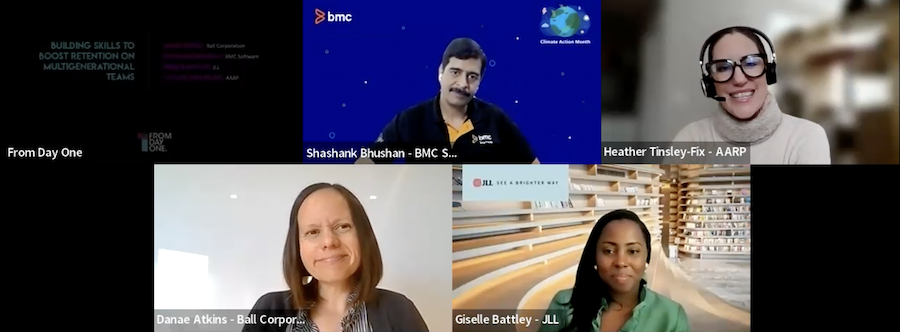How to Build Skills to Boost Retention on Multigenerational Teams


“With the population aging, one of the concerns we hear from employers is that they’re worried about a good portion of their workforce leaving,” said Heather Tinsley-Fix, a senior advisor for financial resilience at AARP. “Because when they leave, they’ll take this huge reservoir of institutional knowledge, professional networks, and wisdom with them.”
How to keep this lucrative knowledge inside an organization and pass it across generations, was the central topic of conversation during a From Day One webinar about building skills to boost retention on multigenerational teams, moderated by Tinsley-Fix.
Among the strategies that panelists shared for moving the knowledge and expertise from older generations to younger ones, mentorship was the most popular.
“We have a lot of people who have worked on mainframe technologies for 35 or 40 years,” said Shashank Bhushan, chief talent development architect at IT services company BMC Software. “The knowledge that they have is not easily transferable.”
BMC Software matches senior team members with younger ones, even sending the older ones abroad for concentrated mentorship time with their colleagues around the world. As a perk, mentors can take a partner or spouse with them, making a vacation out of the deal. But Bhushan noted that you don’t necessarily have to incentivize mentorship all the time. “People take a lot of pride in being able to transfer and transition their knowledge out to younger people and to mentor them,” he said.
At Ball Corp., the world’s largest maker of food and beverage cans, long-tenured employees on the manufacturing floor often transition away from overnight shifts and onto special projects that let them train more junior workers on their institutional expertise. “That works better for them,” said Ball’s director of HR business partners Danae Atkins. “It’s more of a stable 9-to-5, or a consulting basis, but it gets them out of the shift work, it gives them that fulfillment, and it also helps us leverage their knowledge.”
At corporate real estate firm JLL, Giselle Battley, the global head of early career talent, facilitates knowledge transfer in both directions. The company lets workers at any level opt in to be mentors. “I might go find someone who’s earlier in their career but has a specialty in a space that I want to learn about,” she said.
Mentorship and sharing knowledge across generations is all well and good, but panelists agreed that the challenge for most is finding the time to teach, and learn, something new. “Time is a precious commodity, even sometimes more than monetary resources,” said Atkins. “To carve out the time and the space, sometimes we’re able to get creative about this, like pulling all executives into a cohort program, or when we have some downtime in our plants, using that for training time.” You can encourage people to make time by building it into general performance expectations, she said. “If it’s important to your boss, it’s important to you. That’s often what motivates people to be able to carve out that time.”

When time is a luxury, appeal to a worker’s sense of the future, Atkins said. “That point-of-need use has been very helpful for us. If you can show someone how this new skill will help them right now or how it will help them get to the next role, they’re more likely to jump in.”
Battley said young workers are eager in this way, and employers can leverage mentorship from older workers in their retention strategy. “Their intent to stay with an organization is really dependent upon our ability to continue to grow them, develop them, and move them into new positions,” said Battley.
Employers can’t expect workers to sign up for just any kind of skill development. “If you go into a room and ask people, ‘Do you want to grow?’ All hands will go up. But when it comes down to actual learning, the numbers drop dramatically, and it’s for a variety of reasons,” Bhushan noted. The first, he said, is time. The second is relevance.
Younger workers with a career ahead of them are more incentivized to learn, but the knowledge has to fit into career growth, not just knowledge for knowledge’s sake. “There is an assumption that they have more time,” said Battley. That may be the case, “but they don’t want to use that time for this.”
Employees have to know that their new skills will be put to good use, but it doesn’t necessarily have to be tomorrow. “That’s part of the wisdom for getting people to engage in the training: It’s good for me here and it grows me here, but I also know that my company is investing in my future, no matter where I choose to make that future.”
Editor’s note: AARP, who sponsored this webinar, has partnered with MindEdge Learning to create a skills-building platform for employers to upskill their employees regardless of age. The course catalog includes a range of high-demand skills as well as durable soft skills to enhance productivity and contribute to the growth of your workforce and company. If you’re interested in signing up or just hearing more about these courses, add your name to the Google form here.
Emily McCrary-Ruiz-Esparza is a freelance journalist and From Day One contributing editor who writes about work, the job market, and women’s experiences in the workplace. Her work has appeared in The Washington Post, Quartz at Work, Fast Company, Digiday’s Worklife, and Food Technology, among others.
(Featured photo by Vanessa Nunes/iStock by Getty Images)
The From Day One Newsletter is a monthly roundup of articles, features, and editorials on innovative ways for companies to forge stronger relationships with their employees, customers, and communities.